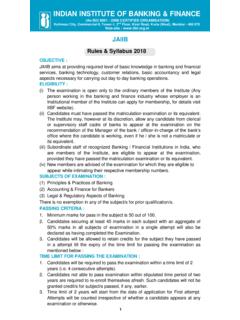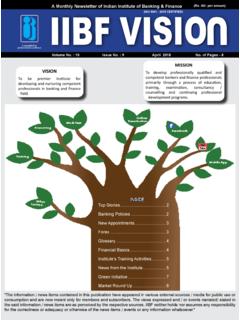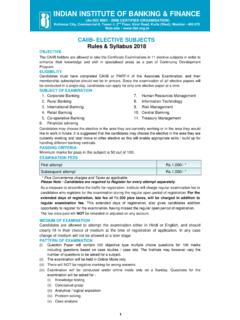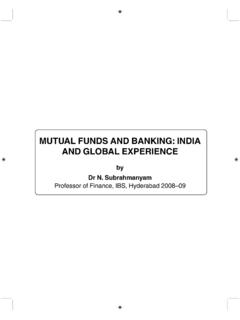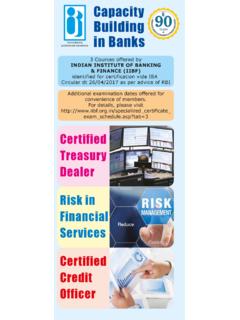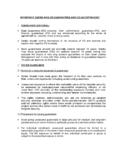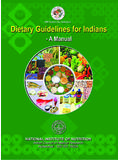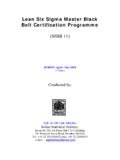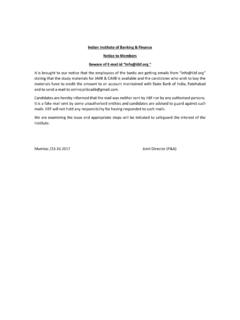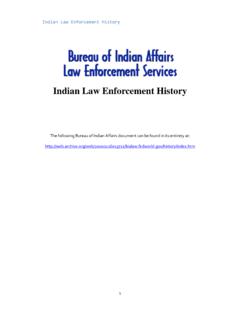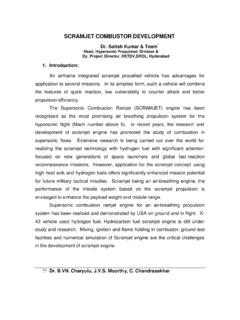Transcription of INDIAN INSTITUTE OF BANKING & FINANCE,
1 INDIAN INSTITUTE OF BANKING & finance , MUMBAI. EXAMINATION: CAIIB. Question paper pattern for the December 2005 examination and onwards: The examination will be conducted purely on objective mode/multiple choice questions basis-offline. There will be about 90 questions each in all the three papers viz. 1. Risk Management, 2. Financial Management and 3. General Bank Management The time alloted will be 120 minutes per paper All the papers will have two sections (under two broad categories of questions) as listed below: The pattern will cosists of the following two categories: 1. True or False Questions }.
2 2. Fill in the blanks } Category I. 3. Tick which is most appropriate }. 4. Small case lets }. 5. Big cases } Category II. 6. Problems etc. }. Category I questions will be 50 questions for 50 marks and Category II type questions will be 40 questions carrying 50 marks. In case of General Bank Management paper questions have been put module wise, hence there will be four sections for each of the modules given in the courseware, but the broad category wise allocation of marks will be as above. However all the questions will be given with multiple choices and the candidates are required to tick the most appropriate answers.
3 Candidates can use calculators to calculate etc. in case of problems and wherever such calculations are called for. However to repeat, they are expected to tick only answer in the book specially supplied for the same. 1. There will be negative marking for wrong answers. Candidates are therefore advised not to resort to guessing while answering. If answers are not fully known, don't attempt, to avoid getting negative marks. Such negative marks may affect the final outcome. Read the questions very carefuly and tick the most appropriate answers, as the questions are also based on the cases/problems.
4 The candidates are expected to use their analytical, problem solving, decision making ability while answering such questions. So the answers should be most appropriate to the situation cited. A FEW SAMPLE/MODEL QUESTIONS ARE GIVEN TO GET A FEEL. OF THE QUESTION PAPER PATTERN. (SAMPLE IS INDICATIVE AND NOT EXHAUSTIVE). Before starting to attempt/answer the question paper, candidates should read the instructions very carefully, repeat very carefully. Please note that for candidates convenience, correct answer has been marked against the question. 2. SUBJECT-RISK MANAGEMENT. 1. Net Interest income is a) Interest earned on advances b) Interest earned on investments c) Total interest earned on advances and investment d) Difference between interest earned and interest paid (d).
5 2. Interest rate risk is a type of a) Credit risk b) Market risk c) Operational risk d) All the above (b). 3. European option can be exercised on any day at the option of the buyer on or before the expiry of the option. a) True B) False (b). 4. If the volatility per annum is 25% and the number of trading days per annum is 252, find the volatility per day. a) b) c) 158%. d) (a). 5. The June 1999 Basle Committee on BANKING Supervision issued proposals for reform of its 1988 Capital Accord (the Basle II Proposals). These proposals contained MAINLY. I) Settlement risk management II) Capital requirements III) Supervisory review IV) The handling of hedge funds V) Contingency plans VI) Market discipline 3.
6 (a) I,III and VI (d). (b) II, IV and V. (c) I,IV and V. (d) II, III and VI. Case Study I. You are working as a Middle Level Executive with Modern Bank Ltd.,' The MIS Department has submitted the following Statistics from which you are required to estimate the likely Capital Funds required by the Bank as of March, 31st, 2007 taking into account the Basel II implementation compliance. i) Risk-Weighted Assets for Credit Risk likely to be , crores ii) Capital Allocation for Market Risk to be crores iii) For Operational Risk following Data available. The bank is required to calculate Capital Charge for Operational Risk by Basic Indicator Approach.
7 Year 31-03-2004 31-03-2005 31-03-2006. Gross Income (Amount in Crore). Note: Capital Adequacy prescription applicable to INDIAN Banks has to be considered for calculation. Answer the following five questions based on above facts. 6. As per Reserve Bank of India directives the Minimum Capital Adequacy Ratio and minimum Tier I capital the Modern Bank is required to maintain as on should be _____ respectively. a) 8% and 4%. b) 9% and c) 9% and d) 12% and not specified (b). 7. The Basel Committee has defined gross income as net interest income and plus net non-interest income and has allowed each relevant national supervisor to define gross income in accordance with the prevailing accounting practices.
8 Accordingly the Reserve Bank of India in the draft guidelines issued 4. on for implementation of the new capital adequacy framework has modified the Gross Income definition slightly. The Net Interest Income has been replaced by a) Net Profit b) Operating Profit c) No Changes made d) Interest Expended (a). 8. Based on the Gross Income given above, the likely Capital Charge for Modern Bank Ltd., as on March 31, 2007 to cover Operational Risk under Basic Indicator Approach shall be (a) 375 crores (b) 540 crores (c) 450 crores (d) 360 crores (c). 9. The Modern Bank Ltd., will require total Capital Funds for covering Credit Risk.
9 As on March31,2007 to comply Basel II norms of crores. a) 5400 crore b) 4500 crores c) 4800 crores d) crores (a). 10. The Modern Bank Ltd., should have minimum of Crores as Tier I capital at the rate of minimum of _____% respectively as per RBI. guidelines applicable to INDIAN Banks. a) b) 2700, c) 2400, d) 2400, (b). 5. SUBJECT -FINANCIAL MANAGEMENT. Based on the following information, Answer Questions 1 to 3. Sales (80% in credit) lakhs, Opening debtors ,80,000, Discount ,000, Bad debt ,000, Cash and Cheques received ,80,000, Cheques dishonoured ,200 (expected to realise 50% from that debtor).
10 Closing creditors ,70,000, Purchases lakhs (25% in cash), Paid to creditors ,25,000, Goods returned ,000. Cost of goods sold / sales = 75%. Closing stock of finished goods : lakh Opening stock of finished goods : lakh Assume 1 year = 360 days. 1. The inventory turnover ratio is: a. 12. b. 24. c. 36. d. None of the above (a). 2. The average collection period is: a. 60 days b. 59 days c. 58 days d. None of the above (b). 3. The average payment period is: a. 250 days b. 256 days c. 146 days d. 186 days (c). 4. A firm has an opening of stock of ,000, Closing stock of ,000. and Cost of goods sold ,40,000.
